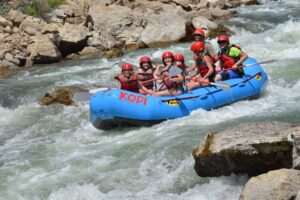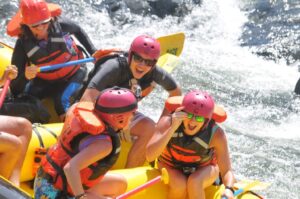Equipment needed for whitewater rafting includes a life jacket, helmet, paddles, and a raft. Whitewater rafting is a thrilling adventure sport that involves navigating down rushing rivers and rapids in an inflatable raft.
Before embarking on this adrenaline-pumping activity, it is essential to ensure that you have the proper equipment to ensure your safety and a successful experience. The most critical equipment needed for whitewater rafting includes a personal flotation device or life jacket, a helmet, a paddle, and a raft.
Additionally, other items such as wetsuits, splash jackets, and river shoes are recommended to protect against the cold water and elements. Proper preparation and equipment will ensure an unforgettable and safe adventure on the river.

Credit: nomadicated.com
Importance Of Proper Whitewater Rafting Equipment
Whitewater rafting can be an incredibly thrilling and rewarding activity. However, it is essential to have the necessary equipment to ensure everyone’s safety. In this blog post, we will explore the importance of proper whitewater rafting equipment and the risks involved in not having it.
We’ll also provide safety tips to keep in mind when rafting, ensuring that everyone has a good time.
Why Having The Right Equipment Matters
When you’re rafting, having the proper equipment can make a significant difference. Here are a few reasons why:
- Proper equipment enhances safety: Having the right equipment helps you stay safe while on the water. For example, wearing a life jacket can help you stay afloat if you fall in and rapids are too strong. Similarly, a helmet can help protect your head if you hit a rock.
- Improved performance: Proper equipment can significantly improve your performance. For example, paddles that are too long or too short can affect your stroke and make it harder to get where you want to go.
- Better preparedness: Whitewater rafting equipment can help you be better prepared for emergencies. Having a first aid kit, for instance, can help you be ready to deal with minor injuries while waiting for help to arrive.
Risks Of Not Having Proper Equipment
If you don’t have the right equipment, there are several risks involved, including:
- Injury or death: Not having the right equipment can make it much more dangerous to go rafting. For instance, if you’re not wearing a life jacket and fall in, you could drown.
- Poor performance: Not having the proper equipment can make it much hard to navigate through the rapids. For instance, the wrong paddle length can make it challenging to make turns.
- Legal implications: If you don’t have the right equipment, you could face legal implications. For instance, if you’re caught without a life jacket, you could potentially be fined.
Safety Tips To Keep In Mind When Rafting
To ensure everyone has a good time on the water, here are a few critical safety tips to keep in mind:
- Wear proper equipment: Make sure you’re wearing the proper equipment, including a life jacket and helmet.
- Listen to your guide: Always listen carefully to your guide’s instructions and follow them closely.
- Stay seated: Always stay seated in the raft, as standing up can be incredibly dangerous, particularly when going through rough rapids.
- Stay aware: Keep an eye on the water around you and be mindful of any potential hazards, such as rocks or branches.
- Stay calm: If you fall in the water, try to stay calm as panicking can make it harder to make it back to the raft.
By following these safety tips and ensuring you have the right equipment, you can have a fun and safe whitewater rafting experience.
Essential Whitewater Rafting Equipment You Need
Whitewater rafting is an exhilarating outdoor activity that involves navigating through rough, fast-moving waterways. It’s the perfect way to satisfy your adrenaline cravings while enjoying the beauty of nature. However, it can also be dangerous if you’re not properly equipped with the right gear.
We’ll discuss the essential whitewater rafting equipment you need to have a safe and enjoyable experience.
Personal Flotation Devices (Pfds)
Personal flotation devices, commonly known as pfds or life jackets, are essential pieces of equipment for whitewater rafting. They keep you afloat in the water and reduce the risk of drowning in the event that you fall out of the raft.
Types Of Pfds And When To Use Them
There are different types of pfds available, each with unique features that cater to different levels of skill and water conditions. Here are some common ones:
- Type i: For use in open, rough waters. Ideal for those who lack experience in rafting.
- Type ii: Suitable for calmer waters, where rescue is highly likely.
- Type iii: Designed for swift water or whitewater situations because they offer a greater range of motion and flexibility.
- Type v: Specialty jackets that perform distinct functions, usually recommended for professional river guides.
Proper Fit And Care Of Pfds
It is crucial to check your pfd’s proper fit before going on your rafting trip. A well-fitting pfd can save your life. The following tips for ensuring proper fit and care will help you:
- Choose the right type of jacket that suits your skill level and water conditions.
- Check the size chart and match it with your measurements to ensure a snug fit.
- Make sure it’s not too tight or too loose.
- Read and follow the manufacturer’s instructions for maintaining your pfd.
Helmets
Helmets are another essential piece of whitewater rafting gear. They protect your head from impact in case of an accident, such as hitting a rock.
Types Of Helmets And When To Use Them
There are two primary types of helmets used in whitewater rafting:
- Full-face helmets: These provide the most protection and cover the face, chin, ears, and back of the head. Ideal for extreme rafting, including high-speed rapids.
- Half-face helmets: These protect the forehead, top of the head, and back of the head. Ideal for less extreme rafting conditions.
Proper Fit And Care Of Helmets
Wearing an ill-fitting helmet can cause more harm than good. Helmets that fit correctly rest comfortably on the forehead, with no gaps around the ears, and should not wobble or shift around while you move. Proper care of your helmet comprises of the following:
- Check for any cracks or damage before using.
- Store it in a cool, dry place away from sunlight.
- Follow the manufacturer’s instructions for cleaning and maintenance.
Paddles
Paddles are used to maneuver the raft through the water and keep it on course. They come in various shapes and sizes, each designed for different purposes.
Types Of Paddles And When To Use Them
There are two main types of paddles in whitewater rafting:
- One-piece paddles: These are sturdier, more durable, and better suited for experienced rafters.
- Two-piece paddles: These are adjustable and easy to transport, making them ideal for beginners.
Proper Care And Maintenance Tips
Proper care and maintenance of your rafting paddles can extend their lifespan and improve your rafting experience. Here are some easy tips you can follow:
- Rinse them with freshwater after each use.
- Store them in a cool place and avoid storing in direct sunlight.
- Check to ensure that there are no cracks or damage that could affect their performance.
These are the essential whitewater rafting equipment you need to ensure your safety and maximize your enjoyment. Make sure you have them before embarking on your next rafting adventure!
Frequently Asked Questions Of Equipment Needed For Whitewater Rafting
What Equipment Do You Need For Whitewater Rafting?
You need a helmet, life jacket, paddle, wetsuit or drysuit, and river shoes.
How Do You Choose The Right Type Of Raft For Whitewater Rafting?
Choose a raft based on the location, skill level and size of the group.
Can You Wear Contact Lenses While Whitewater Rafting?
Yes, but water can make contact lenses slippery. Wear a secure pair of glasses instead.
Conclusion
As you can see, whitewater rafting is an exhilarating adventure that requires adequate preparation and equipment. From the right pfd to the right dry bag, each piece of gear is crucial to ensuring a successful and safe trip. Remember to always check your equipment before hitting the river and follow basic safety measures.
Moreover, the equipment needed for whitewater rafting may differ based on the type of rafting trip you choose. Make sure you do your research and consult with professional rafting outfitters to determine what gear you will require. Investing in quality gear will make your rafting experience more enjoyable and memorable.
So, gather your gear, rally your friends, and get set for an unforgettable whitewater rafting adventure. Happy rafting!


